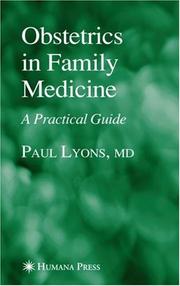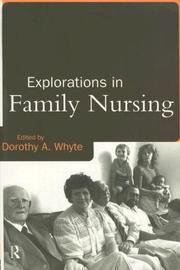| Listing 1 - 10 of 695 | << page >> |
Sort by
|
Book
ISBN: 1437735673 143771160X 1336230851 Year: 2011 Publisher: W.B. Saunders
Abstract | Keywords | Export | Availability | Bookmark
 Loading...
Loading...Choose an application
- Reference Manager
- EndNote
- RefWorks (Direct export to RefWorks)
Family medicine. --- Family practice (Medicine) --- General practice (Medicine) --- Medicine --- Physicians (General practice)
Periodical
ISSN: 26961296 20079710
Abstract | Keywords | Export | Availability | Bookmark
 Loading...
Loading...Choose an application
- Reference Manager
- EndNote
- RefWorks (Direct export to RefWorks)
Family medicine --- Sistema linfático --- Family practice (Medicine) --- General practice (Medicine) --- Medicine --- Physicians (General practice) --- Médecine familiale
Periodical
Abstract | Keywords | Export | Availability | Bookmark
 Loading...
Loading...Choose an application
- Reference Manager
- EndNote
- RefWorks (Direct export to RefWorks)
Family medicine --- Family medicine. --- Family practice (Medicine) --- General practice (Medicine) --- Medicine --- Physicians (General practice) --- Médecine familiale
Book
ISBN: 1461324777 Year: 1985 Publisher: New York ; London : Plenum Medical Book Company,
Abstract | Keywords | Export | Availability | Bookmark
 Loading...
Loading...Choose an application
- Reference Manager
- EndNote
- RefWorks (Direct export to RefWorks)
Decoding the significance of proteinuria as an indicator of severity or prognosis in kidney disease is a stimulating challenge to students and practitioners of nephrology. Sir Richard Bright in 1827 associated pro with the disease that bears his name. In the subsequent more teinuria than a century and a half, however, the meaning of the linkage between proteinuria and renal disease remains elusive. Proteinuria is discovered on routine urinalysis in about 10 million Americans, most of whom express no symptoms of kidney disease, each year. From the studies of Robinson (updated in these pages), we know that proteinuria, per se, can be present for 20 years without change in re nal function, as described in orthostatic proteinuria. By contrast, pro teinuria may be the harbinger of swift kidney destruction, rarely cul minating in clinical collapse, a syndrome typifying "malignant proteinuria" as detailed herein by Avram. Although proteinuria is ubiquitous, an orderly management strategy for rational handling of proteinuria of less than nephrotic range is lack ing. Separation of tubular proteinuria and transient proteinuria of fever is now possible routinely. This book provides a record of the contribu tions of investigators and clinicians whose work forms the substrate for production of understanding and, ultimately, marching orders for prac titioners seeking optimized management for their proteinuric patients.
Family medicine. --- Internal medicine. --- Medicine, Internal --- Medicine --- Family practice (Medicine) --- General practice (Medicine) --- Physicians (General practice)

ISBN: 1280832320 9786610832323 1597451428 1588295109 Year: 2006 Publisher: Totowa, N.J. : Humana Press,
Abstract | Keywords | Export | Availability | Bookmark
 Loading...
Loading...Choose an application
- Reference Manager
- EndNote
- RefWorks (Direct export to RefWorks)
Approximately 21,000 family physicians in the United States regularly perform obstetrics as part of their primary care responsibilities. In Obstetrics in Family Medicine: A Practical Guide, a seasoned inner-city family physician concisely surveys the normal obstetrics encountered in a busy medical practice to provide a practical guide to the evaluation and management of common prenatal, peripartum, and postpartum complications. For each stage, Dr. Paul Lyons addresses the major issues and problems, spelling out in detail management protocols about why and what action is to be taken, when it is to be done, and how it is to be interpreted. The key points for each topic are summarized in tabular form for quick reference, and diagnostic flow charts illuminate all aspects of the decision-making process. Expert advice based on years of experience is also presented concerning physical and ultrasound examinations, laboratory tests, drug toxicities, and screening techniques. For the clinician seeking a point-of-care tool to look up information quickly when attending to patients in the office, a PDA version of the book is available from the Humana website: www.humanapress.com. Concise and clinically oriented, Obstetrics in Family Medicine: A Practical Guide aims to improve the delivery of women's health care, helping both family doctors who are doing obstetrics and those who want to better understand what is happening to their pregnant patients reach a higher standard of care.
Obstetrics. --- Family medicine. --- Maternal-fetal medicine --- Medicine --- Family practice (Medicine) --- General practice (Medicine) --- Physicians (General practice) --- Obstetrics/Perinatology/Midwifery.
Book
ISBN: 2207239888 9782207239889 Year: 1992 Volume: vol *7 Publisher: Paris : Denoël,
Abstract | Keywords | Export | Availability | Bookmark
 Loading...
Loading...Choose an application
- Reference Manager
- EndNote
- RefWorks (Direct export to RefWorks)
Family medicine --- Family practice (Medicine) --- Geneeskunde [Huisarts] --- General practice (Medicine) --- Huisartsgeneeskunde --- Médecine familiale --- Médecine générale --- Primary medical care --- France --- Santé
Book
ISBN: 9780195369854 9780199708628 0199708622 1282544179 9781282544178 0195369858 0190451521 9780190451523 9786612544170 6612544171 Year: 2009 Publisher: New York Oxford university press
Abstract | Keywords | Export | Availability | Bookmark
 Loading...
Loading...Choose an application
- Reference Manager
- EndNote
- RefWorks (Direct export to RefWorks)
Family medicine --- Family Practice --- Family Practices --- Practice, Family --- Practices, Family --- Family practice (Medicine) --- General practice (Medicine) --- Medicine --- Physicians (General practice)

ISBN: 1134785437 1134785445 0203435958 1280018682 9786610018680 9780203435953 0415133491 9780415133494 0415133505 9780415133500 9781134785445 9781134785391 1134785399 9781134785438 Year: 1997 Publisher: London New York Routledge
Abstract | Keywords | Export | Availability | Bookmark
 Loading...
Loading...Choose an application
- Reference Manager
- EndNote
- RefWorks (Direct export to RefWorks)
This book examines the theory behind family nursing, and the value it serves to patients both in the community and in hospitals. Widely applied as a systematic strategy in a whole range of cases, it strengthens the level of care available.
Family nursing. --- Family medicine. --- Family practice (Medicine) --- General practice (Medicine) --- Medicine --- Physicians (General practice) --- Family-centered nursing --- Family medicine --- Nursing
Book
ISBN: 1634852079 9781634852074 9781634851763 1634851765 Year: 2016 Publisher: Hauppauge, New York : Nova Science Publisher's, Incorporated,
Abstract | Keywords | Export | Availability | Bookmark
 Loading...
Loading...Choose an application
- Reference Manager
- EndNote
- RefWorks (Direct export to RefWorks)
Family medicine. --- Primary care (Medicine) --- Primary medical care --- Medical care --- Family practice (Medicine) --- General practice (Medicine) --- Medicine --- Physicians (General practice)
Book
ISBN: 3031298977 3031298969 Year: 2023 Publisher: Cham : Springer International Publishing : Imprint: Springer,
Abstract | Keywords | Export | Availability | Bookmark
 Loading...
Loading...Choose an application
- Reference Manager
- EndNote
- RefWorks (Direct export to RefWorks)
This book provides a simplified guide to history taking by assessing each symptom in detail, highlighting what key questions are important to ask, and which key differentials are essential to rule out. The chapters are well presented and organised in a logical manner, utilising an easily accessible and user-friendly format for solid learning on focused history taking that includes both general and specific information gathering. History Taking in Clinical Practice includes case-based examples throughout as well as short exercises to enhance learning. GPs, junior doctors and medical students seeking an effective approach to history taking will find this book to be an essential resource for daily clinical practice and exam preparation.
| Listing 1 - 10 of 695 | << page >> |
Sort by
|

 Search
Search Feedback
Feedback About UniCat
About UniCat  Help
Help News
News